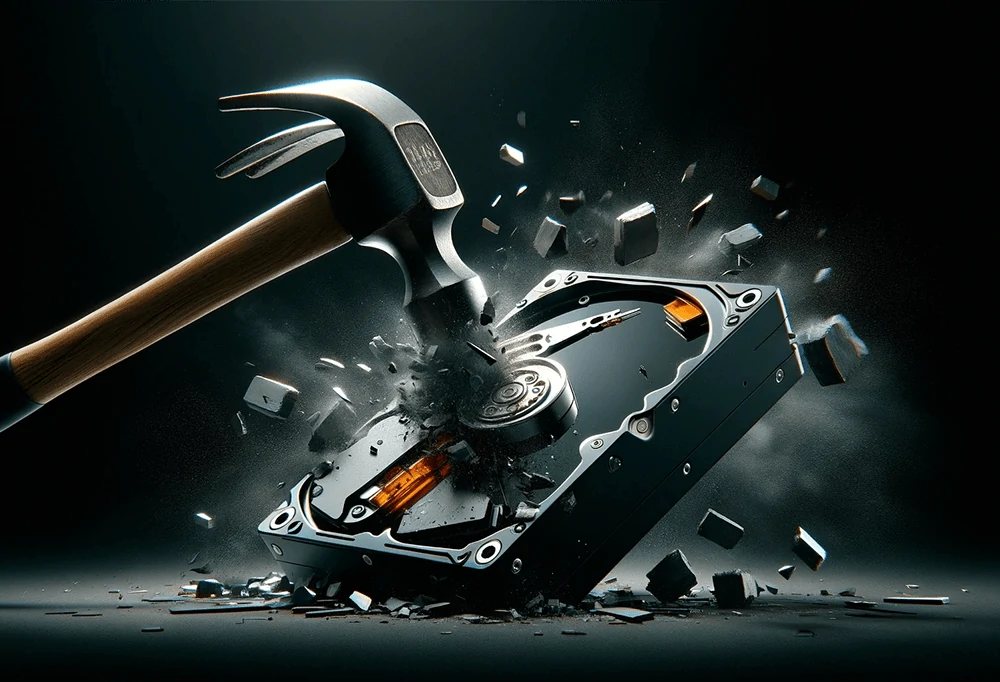how to physically destroy a hard drive
Absolute Erasure: A Comprehensive Guide to Physically Destroying Hard Drives
In today's digital landscape, information security is of paramount importance. Sensitive data, both personal and corporate, requires reliable methods for ensuring its complete and permanent erasure when it's no longer needed. While software-based wiping techniques are widely used, they may not always guarantee absolute data removal. This underscores the critical role of physical hard drive destruction in achieving unparalleled data security.
Physical destruction involves employing mechanical methods to render the hard drive inoperable and prevent data recovery. This process is essential for individuals and organizations adhering to stringent security protocols and mitigating the risk of data breaches. However, effectively destroying a hard drive goes beyond brute force methods. Different techniques offer varying levels of security effectiveness, and the optimal choice depends on factors like data sensitivity and available resources.
By understanding these methods and the necessary safety precautions, you can ensure your data is securely and permanently erased. This guide delves into the complex world of hard drive destruction, exploring how to safeguard your digital footprint from unauthorized access.

This revised introduction emphasizes the importance of data security in the digital age. It uses more formal language like "paramount importance," "underscores," and "mitigating the risk." It also clarifies the purpose of physical destruction and the factors influencing the chosen method.
How to physically destroy a hard drive?
It may involve destroying the hard drive physically, making it impossible for sensitive data to reach unauthorized hands. In fact, this is normally carried out at the lifetime end of a hard drive or in cases where data is extremely sensitive and needs to be permanently destroyed.
Common ways to do this include:
1 . Industrial Shredding:
This method employs specialised, high-powered shredders designed to pulverise electronic media into minuscule particles, often resembling confetti. This process effectively disrupts the internal components of the hard drive, including the platters, actuator arm, and chassis, rendering the data unrecoverable. Shredding is a preferred choice for large organisations and data destruction service providers who handle bulk volumes of storage devices. However, it necessitates access to expensive, heavy-duty machinery.
2. Mechanical Crushing:
This technique utilizes a dedicated mechanical punch or press to deform and fracture the platters within the hard drive, where the data resides. Crushing also damages the spindle, internal mechanics, and casing, guaranteeing the data's inaccessibility. Compared to shredding, crushing can be implemented on a smaller scale, making it suitable for both enterprises and smaller businesses that handle sensitive data. Portable crushers are available for on-site destruction, offering greater flexibility.
3. Drilling or Hammering:
Process: This method involves physically damaging the hard drive platters, where data resides, using a drill to create holes or a hammer for blunt force trauma.
Suitability: This readily available approach is suitable for individuals or small businesses with infrequent hard drive destruction needs.
Considerations: While effective, it can be labor-intensive and requires ensuring comprehensive damage across all data-bearing surfaces.
4. Degaussing:
Process: Degaussing utilizes a powerful magnet to disrupt the magnetic fields, storing data on the drive and essentially wiping it clean.
Application: This method is favored by organizations that must destroy data without physical harm to the drive, potentially enabling component recycling.
Considerations: Degaussers are expensive and require proper maintenance for optimal functionality. Additionally, degaussed drives are typically rendered inoperable due to the erasure of servo tracks.
5. Incineration:
Process: Incineration exposes the hard drive to extreme temperatures, causing its metal and plastic components to melt or vaporize entirely.
Implementation: Specialised facilities handle incineration under controlled conditions, minimizing environmental impact.
Considerations: While incineration guarantees destruction, it necessitates professional handling to manage toxic fumes and comply with environmental regulations.
6. Chemical Destruction:
Process: This method employs strong acids or other corrosive chemicals to dissolve or inflict severe damage on the hard drive's platters and other components.
Usage: Less common than other methods, specialized services typically use chemical destruction to handle and dispose of hazardous materials safely.
Considerations: Chemical destruction poses safety risks without proper protocols and disposal procedures. The environmental impact of utilizing chemicals must also be considered.
Safety in physically destroying a hard drive:
Regardless of the chosen method, prioritizing safety is important. Always wear appropriate protective gear and operate in well-ventilated or controlled environments to effectively manage physical and chemical hazards.
Verification for Enhanced Security:
Following the destruction process, inspecting the drive remnants or employing a third-party verification service can provide additional assurance that data has been irretrievably eliminated. This is particularly crucial for highly sensitive data to prevent potential data breaches.
Physically destroying a hard drive is a critical step in the data lifecycle, particularly when dealing with highly sensitive or confidential information. As explored, multiple methods exist, each with its advantages and suitability depending on security needs and resources.
Responsible execution is paramount. Following proper safety protocols and environmental guidelines is crucial not only for personal safety but also for compliance with legal and ethical standards. Additionally, verifying the destruction process through audits or third-party checks can provide further assurance that the data is completely destroyed.
Embracing these practices not only protects you from potential data breaches but also builds trust with clients and stakeholders who value privacy and security. As technology advances and data becomes ever more critical, secure disposal of data-bearing devices transcends a technical requirement; it's a cornerstone of modern digital responsibility.
As technology advances and data becomes ever more critical, secure disposal of data-bearing devices transcends a technical requirement; it's a cornerstone of modern digital responsibility.





